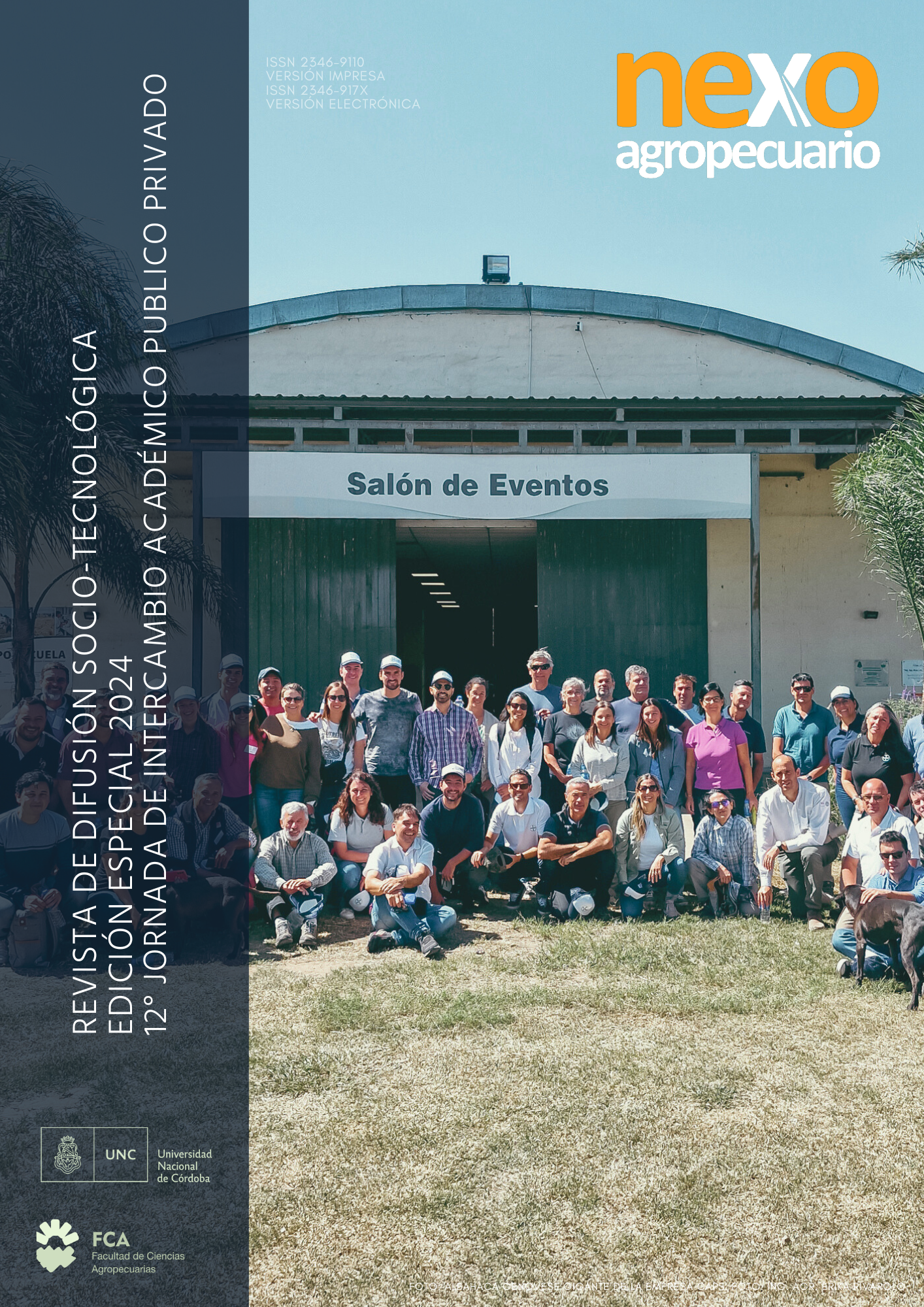APORTES DE CRUZAS DE LÍNEAS TEMPLADAS Y TROPICALES DE MAÍZ (Zea mays L.) EN AMBIENTES DE SIEMBRA TARDÍA EN LA REGIÓN CENTRAL DE ARGENTINA
Keywords:
rendimiento, average temperature, maximum temperature, tropical germplasm, cornAbstract
Corn plays an important economic role throughout the world. It is one of the most widely used cereals as a basis for human and/or animal food and as a supply of raw materials for energy production and industry. Despite its tropical origin, maize is grown in very diverse environments. In fact, the planting area covers a wide range of latitudes, from 58o north latitude in Canada to 40o south latitude in Argentina and Chile (Fischer et al., 2014). In Argentina, the main constraint for maize production is water availability. Maize production has moved away from the traditional temperate production zone towards semi-arid environments and late planting dates (<700 mm per year) with a higher frequency of heat stress events (Maddonni, 2012). Farmers have implemented this practice to reduce the risk of water deficit during the critical flowering period (Otegui, 2021) despite the decrease in environmental conditions (radiation and temperature) for crop growth during the reproductive period. Commercially, the hybrids that lead the preferences of corn producers were characterized by being the product of crossing temperate lines. However, the advantages of tropical corn hybrids have been promoted because they can show greater adaptation to the environment when the optimal planting date is delayed (Valentinuz et al., 2009).
References
Abadassi J., and Herve Y. 2000. Introgression of temperate germplasm to improve an elite tropical maize population. Euphytica 113: 125–133
Abdel-Moneam M.A., Attia A.N., EL-Emery M.I., Fayed E.A. 2009. Combining Ability and Heterosis for Some Agronomic Traits in Crosses of Maize. Pakistan journal of biological sciences: PJBS. 12: 433-438.
Antuna G. O., Rincón S., Gutiérrez E., Ruiz T., Bustamante G. 2003. Componentes genéticos de caracteres agronómicos y de calidad fisiológica de semillas de líneas de maíz. Revista fitotécnica mexicana 26: 11-17.
Betrán F.J., Beck D., Bänzige M., Edmeades G.O. 2003.Genetic analysis of inbred and hybrid grain yield under stress and nonstress environments in tropical maize. Crop Sci.43:807– 817
Cross, H. Z. 1975. Diallel analysis of duration and rate of grain filling of seven inbred lines of corn. Crop Sci. 15: 532-535
De la Cruz-Lázaro E., Castañón-Najera G., Brito-Manzano N. P., Gómez-Vázquez A., Robledo-Torres V., Lozano- del Río A. J. 2010. Heterosis y aptitud combinatoria de 98 poblaciones de maíz tropical. Phyton, International Journal of Experimental Botany 79: 11-17.
Di Rienzo J. A., Casanoves F., Balzarini M. G., González L., Tablada M., Robledo C. W. InfoStat versión 2015. Grupo InfoStat, FCA, Universidad Nacional de Córdoba, Argentina. URL http://www.infostat.com.ar
Doerksen T. K., Kannenberg L. W. and Lee E.A. 2003. Effect of Recurrent Selection on Combining Ability in Maize Breeding Populations. Crop Sci. 43: 1652-1658
Fischer R. A., Byerlee D., Edmeades G. O. 2014. Crop yields and global food security: will yield increase continue to feed the world? ACIAR Monograph No. 158. Australian Centre for International Agricultural Research: Canberra. XXII 634 pp
Gayo S., Brihet J. 2018 ¿Y si el maíz tardío no es lo que parece? Tercer Congreso de maíz tardio. MAIZAR. Consulted: http://www.maizar.org.ar/documentos/sofia%20gayo%20juan%20brihet.pdf
Gobierno de la Provincia de Córdoba. Ministerio de Agricultura y Ganadería. Carta de suelo de la República Argentina, Villa de María, Provincia de Córdoba. On-line 2019-Hoja 2963-32 Villa de María. Consulted: http://suelos.cba.gov.ar/VILLADEMARIA/index.html
Griffing B. 1956. Concept of general and specific combining ability in relation to diallel crossing system. Australian Journal of Biological Science 9: 463-493
INTA. Secretaría Ministerio de Agronomía, Ganadería y Pesca. (1987).Cartas de suelos de la provincia de Córdoba: hoja Oncativo 3163-32 [Carta]. 1:50.000. Córdoba: INTA
Machado J.C., Souza J.C.D., Ramalho M.A.P., Lima J.L. 2009. Estabilidad de los efectos de la habilidad combinatoria en híbridos de maíz. Scientia Agricola 66:494-498
Madonni G. A. 2012. Analysis of the climatic constraints to maize production in the current agricultural region of Argentina—a probabilistic approach. Theor. Appl. Climatol. 107: 325–345
Mickelson H.R., Cordova H., Pixley K.V., Bjarnason M.S. 2001. Heterotic Relationships among Nine Temperate and Subtropical Maize Populations. Crop Sci. 41: 1012-1020
Ortiz R., Taba S., Tovar V.H.C., Mezzalama M., Xu Y., Yan J., Crouch JH. 2010. Conserving and enhancing maize genetic resources as global public goods–A perspective from CIMMYT. Crop Sci. 50: 13-28
Otegui, M. E., Riglos, M., & Mercau, J. L. 2021. Genetically modified maize hybrids and delayed sowing reduced drought effects across a rainfall gradient in temperateArgentina. Journal of Experimental Botany.72(14):5180–5188. https://doi.org/10.1093/jxb/erab139
Priestly, C.H. and Taylor, R.H. 1972. On the assessment of surface heat flux and evaporation using large scale parameters. Monthly weather review. 100(2): 81-92
Rattalino Edreira J. I., Otegui M. E. 2013. Heat stress in temperate and tropical maize hybrids: A novel approach for assessing sources of kernel loss in field conditions. Field Crops Research 142: 58-67
Valentinuz O., Cabello N., Ainelini D. 2009. Respuesta de híbridos tropicales y templados al manejo agronómico de las últimas décadas. Disponible en: http://inta.gob.ar/documentos/respuesta-de-hibridos-tropicales-y-templados-al-manejo-agronomico-de-las-ultimas-decadas/
Vasal S. K., Srinivasan G., Crossa J., Beck D. L. 1992. Heterosis and combining ability of CIMMYT’s subtropical and temperate early-maturity maize germplasm. Crop. Sci. 32: 884-890
Vasic N. J., Ivanovic M. R., Brkic I. J., Bekavac G. F., Zdunic Z. I., Jambrovic A. S. 2006. Evaluation of maize hybrids containiin different proportion of NC298 tropical germplasm line in their male parents. Maydica 51: 79– 88
Wain G., Kain M. S., Moreno O. 1999. Genetic analyses of grain-filliin rate and duration in maize. Field Crops Res 61: 211-222
Whitehead F. C., Caton H. G., Hallauer A. R., Vasal S., Cordova H. 2006. Incorporation of elite subtropical and tropical maize germplasm into elite temperate germplasm. Maydica 51: 43 – 56
Downloads
Published
Issue
Section
License
Copyright (c) 2024 M. L. Ferreyra, C. A. Biasutti

This work is licensed under a Creative Commons Attribution-NonCommercial-ShareAlike 4.0 International License.
Attribution - Non-Commercial - Share Alike (by-nc-sa): No commercial use of the original work or any derivative works is permitted, distribution of which must be under a license equal to that governing the original work.


